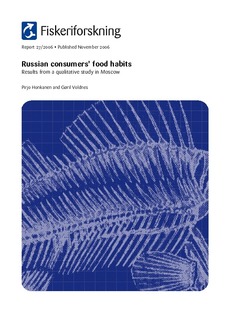| dc.description.abstract | This study is a part of an ongoing three year project aimed at exploring end explaining Russian consumers’ meal structures, consumers’ relative preferences, motives for food choice and the consumers’ perceptions of risks and benefits with foods (with an emphasis on herring). A main point is also to uncover any differences between younger and older generations. We choose to mix qualitative and quantitative methods in the main project. This report is a description of the qualitative part. Qualitative interviews were conducted amongst 21 women in Moscow who were chosen from two age groups, under 30 years and 50 years or older, in order to uncover possible differences in preferences and meal patterns. The purpose of the study was to discover different meal patterns, preferences for herring and possible substitutes, and to explore consumer motivations for food choice. The findings will be used as an input for the design of a survey with larger samples in chosen cities in Russia. The study revealed that three meals per day is quite common in Moscow: breakfast, dinner (or lunch) and supper. The younger women tend to have lighter meals compared to the older generation, and they have adopted “exotic” foods like sushi. They also tend to go to cafés, which is not very common amongst the older women. Concern for weight is common for both groups. Many of the subjects try to avoid food that is fattening, and most of the women in the study seem to equate slimness with being healthy. Fish and herring are not mentioned when discussing Russian traditions, and herring is not mentioned in eating patterns. But when asked, everybody reports eating and liking herring, even the younger people. This would suggest that herring is not consumed very often by most of the subjects. Herring is mostly consumed for supper (salted herring with potatoes and onions) or for special occasions as an appetiser. The possible substitutes are thus numerous. Price, familiarity of products, natural content of food and weight control seem to be the most important motives when choosing food. Avoiding additives and e-ingredients seems to be a very common goal for the women. Health is also an important motive, and the subjects reported many healthy and unhealthy foods. They were, however, surprisingly little aware of why some foods are healthy or risky. | |
